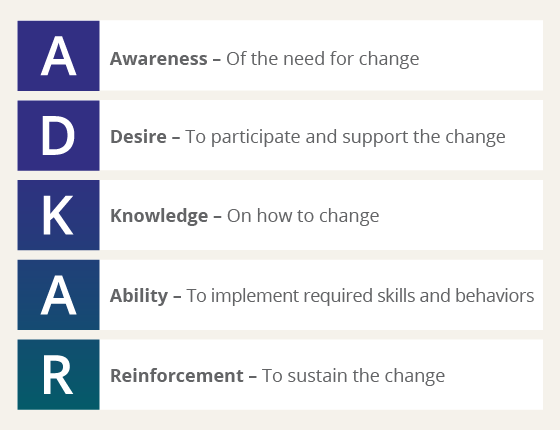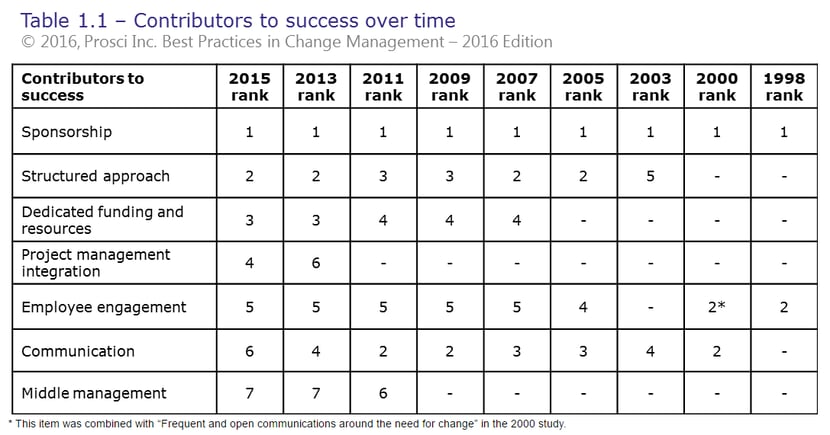Don't Be Fooled - Improvement Still Requires Change Management

6 Mins
Updated: November 9, 2022
Published: July 20, 2015

In Prosci's experience, there is one particular type of change that is often overlooked when we talk about which efforts need change management. Replacing a technology or system, introducing new and documented processes, restructuring or merging - these are all easily identified as change efforts that require change management. However, when organizations work to introduce improvement systems, they often forget that change management is a necessary and critical element to being successful. Introducing an approach or system for improving the organization requires as much, if not more, change management than any direct change to how the business operates.
What is an Improvement System?
We use the term "improvement system" to mean the approaches, methodologies, tools and technologies that organizations use to bring about improvements in how the organization operates. These are management approaches for isolating issues and finding solutions, and they are often the catalyst for specific changes to technologies, processes, job roles or organization structures. Some examples of these systems that are popular in industry today include:
- Lean manufacturing – a systematic approach to eliminating waste
- Business process management – a systematic approach to documenting and streamlining processes within the business
- Appreciative inquiry – a systematic approach to engaging individuals around what is working to improve effectiveness
- Six Sigma – a systematic approach to eliminating variation of outputs in business processes
- ISO 9000 – quality management certification and standards
Did you know the Prosci Methodology was completely refreshed in 2021?
Discover how we made it more actionable and effective than ever!
You may be familiar with some of these systems that are being used by your organization. You may have other systems your organization is applying to improve performance. The important note here is that each of these improvement systems requires individuals to behave differently. Just as a new web-based tool for your sales force requires a change in individual behavior and work flow, improvement systems require a change in how people in the organization do their jobs.
Improvement systems pose their own unique change management challenges. And when the people side of an improvement system is ignored, there are consequences like slower adoption, work arounds, resistance and ultimately not creating the necessary improvements for the organization.
Key takeaways
- Improvement systems and approaches cause change and require change management
- Individual change management still applies
- Rolling out a common change management approach (or project management approach) is a change that must be managed
Waves of Change
When thinking about installing improvement systems like Lean or Six Sigma, it is important to think about the two waves of change that are created from a people perspective. The first "wave" is the actual implementation of the improvement system. The second "wave" - or more accurately second "waves" - comes from applying or using the improvement system. These are the particular recommendations that result when the improvement system is put to use. Two examples below illustrate these waves of change:
Example of Lean
- Wave 1: "We are rolling out Lean in our manufacturing operations"
- Wave 2: "After applying the Lean approach, we are eliminating waste in the X area by doing Y"
Example of business process management
- Wave 1: "We are installing business process management"
- Wave 2: "The processes in the sales group have been documented, and the following processes will be changed: XYZ"
In many cases, the first "wave" of an improvement system is the one that is not managed effectively from a people side of change perspective. Organizations and leaders become so enamored by the improvement system they have decided to employ that they neglect to bring people along in the process. Perhaps a single email goes out from the new head of Lean that says "we are using Lean" - or perhaps there is a single newsletter article about how the organization will begin using Appreciative Inquiry. Then, all of a sudden front-line employees start hearing about changes they will have to make to their day-to-day work, with no context as to why the changes are happening in the first place.
Organizations that are installing new approaches to improving how they operate must first manage the change of introducing that new improvement system, and then they must manage the changes that come from applying the system. Both waves of change need to apply a structured process for building employee engagement and support - i.e. they both need change management to be successful. The results of not managing these waves can be resistance, opting out of the improvement system and a general feeling of "here we go again" or "well, this must be the next flavor of the month that management is chasing."
Importance of the Individual
There are a number of lessons that can be learned by applying an individual change model to the installation of an improvement system. Below is a simple breakdown of the Prosci ADKAR Model for the change:
Awareness of the need for the new improvement system
- Why is the improvement system needed?
- What are the risks of not using this improvement system?
- Why is this improvement system being implemented now?
- What is the general nature of this change - what does it mean to use Lean? or BPM? or Appreciative Inquiry? or Six Sigma?
Desire to participate and support the new improvement system
- What are the organizational drivers causing us to bring this new improvement system into the organization?
- What are my personal motivators for getting involved in Lean or BPM or Appreciative Inquiry or Six Sigma (for example)?
Knowledge on how to use the new improvement system
- What will be my role in using the new improvement system?
- What do I need to know to be successful using the new improvement system?
- When will I be trained on how the new improvement system works?
Ability to implement the skills and behaviors required by the new improvement system
- What exactly will I be doing differently as a result of the new system?
- When will I have a chance to practice?
- Where do I go for support and assistance to be successful as part of this new system?
Reinforcement to sustain the new improvement system
- How do I know the organization is committed to using the new improvement system?
- Are senior leaders really committed to making this successful?
- Will this new approach be discarded next month?
As with any change, the success of an improvement system will ultimately be tied to whether or not individuals can make their own personal transitions successfully. The ADKAR Model provides an effective framework for thinking through the individual change management aspects of the changes associated with implementing a new approach to improving how the organization operates.
 Change Management Best Practices
Change Management Best Practices
Ultimately, a structured change management approach should be applied to the effort of rolling out a new way of improving how the business or organization operates. But for now, think about just a few change management best practices and how they apply to new improvement systems.

Top contributor to success
In all nine of Prosci's change management benchmarking studies (2015, 2013, 2011, 2009, 2007, 2005, 2003, 2000, 1998), participants identified active and visible executive support as the number-one contributor to success. Why would this be any different when implementing a new improvement system? Senior leaders must be effective sponsors and stewards of the new improvement system - whether it is Lean, Appreciative Inquiry or any number of approaches. They must demonstrate their own and the organization's commitment to the system and communicate why it is being rolled out. They must also build a coalition of support with other key managers across the organization.
Use of a structured process
Change management is not effective when it is ad hoc or when it consists solely of a communication or training plan. When a holistic and structured process for change management is applied to the improvement system effort, a complete strategy is created along with a full set of customized and targeted change management plans. This was identified as the second overall contributor to success in the 2015 study, and the thinking is still applicable when the change is "implementing a new improvement system."
Dedicated resources for change management
Change management doesn't happen if there is not someone dedicated to it. So, when a special task force is assembled to bring Lean into an organization, someone on that team should be tasked with the people side impacts of implementing Lean. Project teams, especially when they are formed around an improvement methodology, tend to focus on the training and application of the methodology and neglect bringing other employees along in the process.
Communication
Communication is critical, but it needs to be coming from the preferred senders and should utilize face-to-face vehicles whenever possible. This means that simply announcing Six Sigma in an email is not enough. Senior leaders, managers and supervisors should be utilized as communicators to the people that report to them.
Anticipating and mitigating resistance
Any change to how people work will face resistance. When direct changes are made to how someone works, the resistance can be very active and direct. However, resistance to new improvement systems can often show up as apathy and disinterest. While not as blatant, this type of resistance is equally damaging to the effectiveness of the new improvement system. Work to identify where this resistance is likely to come from, what it might look like and how the most likely objections can be addressed early in the deployment effort.
Footnote on Rolling Out
Change Management or Project Management
The examples so far have related to particular operational and collaborative systems like Lean, Appreciative inquiry and Six Sigma. However, there are two prominent improvement systems where this thinking should also be applied:
- Adopting a common approach to project management
- Deploying change management competencies
When an organization decides to adopt a common approach for project management or change management, it is creating a change to how people work. Think about this from the perspective of an experienced project manager. For her entire career, she has been managing projects by following a process and using a set of tools she created from her numerous experiences. Then one day, someone sends an email that says: "We have adopted a standard project methodology. Starting tomorrow, you will follow our new process and use our tool set." This is a dramatic people-side change, but one that is often ignored or neglected. The team who has spent months researching and identifying the organizational standard may think that they are not causing a change, they are merely deploying a standard approach. But for the people who are managing change, the standard approach can be incredibly disruptive. Likewise, when you begin asking senior leaders to be good sponsors and managers to coach their employees through change as part of your change management plans, you are asking them to change how they work.
While change management and project management are disciplines applied to particular changes in an organization, the broader deployment or adoption of a common methodology is a significant change management challenge - one that needs the same rigor and structured process as any change that impacts how people do their jobs.
Change Management and Improvements
This blog examined some of the change management implications of installing a new improvement system in an organization. Ask yourself the following questions:



